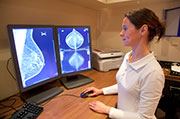
WEDNESDAY, Dec. 31, 2014 (HealthDay News) — Women who have a pre-cancerous condition known as atypical hyperplasia of the breast are at higher risk of developing breast cancer than experts had believed, a new study finds.
Hyperplasia is an overgrowth of cells. When it occurs in a distorted pattern, it’s called atypical hyperplasia. This condition is found in about one-tenth of the more than one million breast biopsies with benign findings done in the United States each year, according to researchers from the Mayo Clinic.
In the new study, the researchers found that about 30 percent of the women with atypical hyperplasia developed breast cancer in the 25 years after the diagnosis.
While experts have always known that atypical hyperplasia increases the risk of breast cancer, the new finding gives women with the condition more solid information about the extent of the risk, said study researcher Dr. Lynn Hartmann, a professor of oncology at the Mayo Clinic in Rochester, Minn.
Before the study, experts believed that women with atypical hyperplasia had about a four times higher risk of breast cancer, she said. That doesn’t tell women their specific individual risk, however, Hartmann noted.
In the study, Hartmann’s team followed nearly 700 women diagnosed with atypical hyperplasia at the Mayo Clinic between 1967 and 2001. After an average follow-up of more than 12 years, 143 women had developed breast cancer.
Hartmann’s team validated the findings with a separate group of women with the condition at Vanderbilt University. Both sets of data found that around 30 percent of the women with atypical hyperplasia developed breast cancer.
As the extent of the hyperplasia increased, so did the risk, the investigators found.
The new research gives women some valuable information, according to two experts who reviewed the findings. One strength of the study was the “sizable sample of women followed for a long time,” said Robert Smith, director of cancer screening for the American Cancer Society.
“We’ve always known their risk was higher,” Smith said of women with the condition. However, the new study provides long-term data, he said, and shows a risk higher than most experts believed it to be.
Dr. Laura Kruper, a breast surgeon and co-director of the Breast Cancer Program at City of Hope Cancer Center in Duarte, Calif., added, “I think the news is atypical hyperplasia is much more serious than we have been taking it. When you say a cumulative risk of 30 percent at 25 years, that is pretty serious,” Kruper said.
Overall, about one in eight U.S. women, or 12 percent, will develop breast cancer in their lifetime, according to estimates from the American Cancer Society.
“We as a medical community need to pay more attention to this,” Kruper said of the higher risk finding.
What should women do who are diagnosed with the condition? They can discuss with their doctor whether to use chemopreventive medicines, such as tamoxifen or aromatase inhibitors, which are given to women who have a higher than average risk of breast cancer, the experts agreed.
Many of the women in the study developed a type of cancer known as estrogen receptor-positive, which requires estrogen to grow, Hartmann noted. That would suggest that taking the chemopreventive medicines — which work by reducing estrogen — would lower that risk, she said.
Women can also discuss with their doctor whether to get a screening MRI in addition to a mammogram, the experts suggested. Under the current guidelines from the American Cancer Society, Smith said, women with atypical hyperplasia are put into an intermediate-risk group. The guidelines currently say there isn’t enough evidence to recommend for or against MRI as an additional screening, Smith said.
The new research provides additional data, however, he said. Under current ACS guidelines, a yearly mammogram and MRI are suggested for women who have a lifetime breast cancer risk of 20 to 25 percent, using standard risk models.
Hartmann is hopeful that the new findings will trigger review of the guidelines by the society and other groups.
Meanwhile, she said, women’s screening decisions should be based on their other individual risk factors. “If a 70-year-old woman has atypical hyperplasia but fatty breasts, she may not need a screening MRI, because her mammogram is so easy to interpret,” she said. Having non-fatty, or dense, breasts, can make it difficult to spot cancer on a mammogram.
On the other hand, a woman in her 60s with dense breasts and atypical hyperplasia might consider a screening MRI in addition to a mammogram, she said.
More information
To learn more about hyperplasia, visit the American Cancer Society.
Copyright © 2024 HealthDay. All rights reserved.

